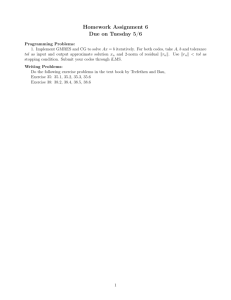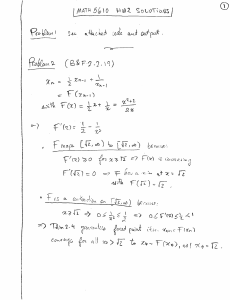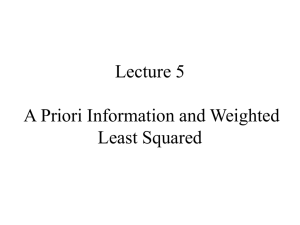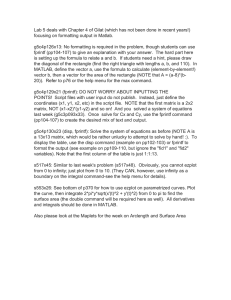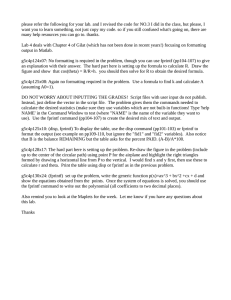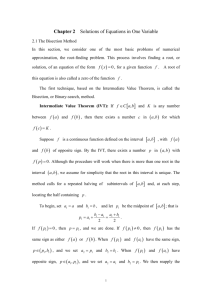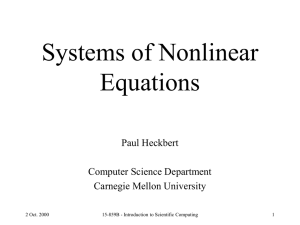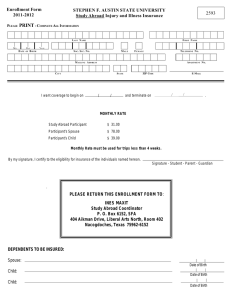Document 11264966
advertisement
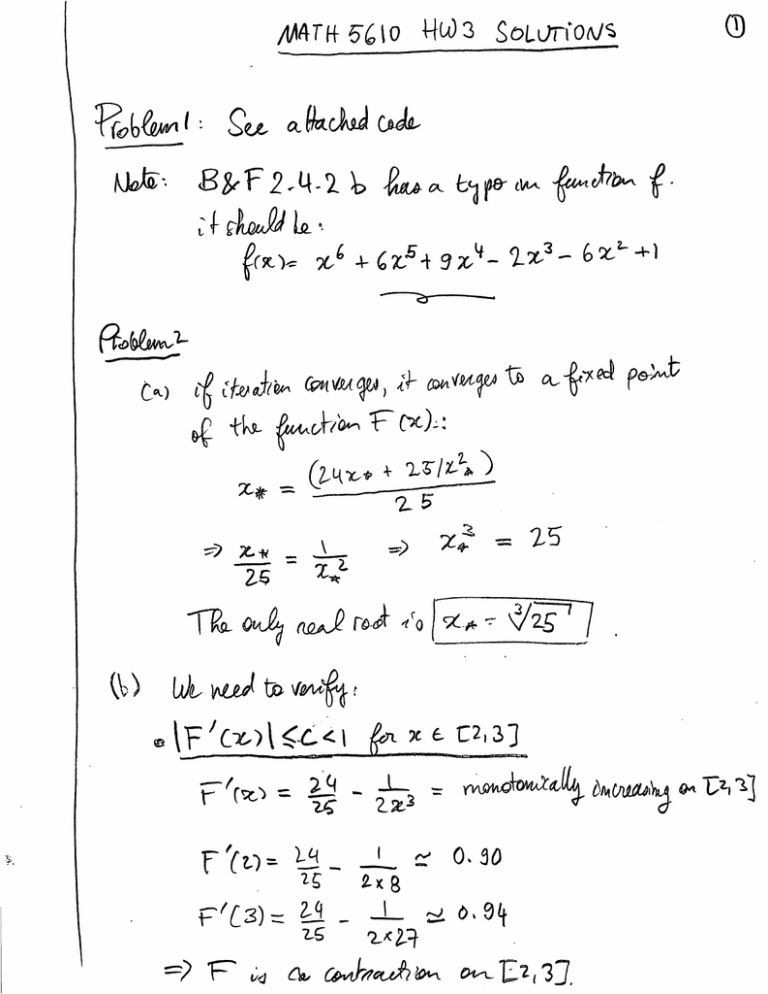
Printed by Fernando Guevara Vasquez Oct 07, 11 11:05 output.txt >> prob1 Part a: NM= 0.73907868 in 17 iter MNM= 0.73908513 in Part b: NM= −2.87939396 in 15 iter MNM= −2.87938523 in >> prob2 fixed point Steffensens root 2.92403530 2.92401774 iter 14 13 g evals 13 8 true value: (25)^(1/3) = 2.92401774 >> prob3 −−−−− part a −−−−− found root r1 = 4.123105626 in 5 iterations found root r2 = −4.123105626 in 8 iterations deflated polynomial is: 1.000000000000000 4.999999999999526 7.999999999999584 Page 1/1 6 iter 5 iter with roots: −2.499999999999763 + 1.322875655532586i −2.499999999999763 − 1.322875655532586i the roots according to Matlab are: −2.499999999999999 − 1.322875655532298i −2.499999999999999 + 1.322875655532298i −4.123105625617663 4.123105625617665 −−−−− part h −−−−− found root r1 = 0.5857864376 found root r2 = 3.414213562 found root r3 = 3 there are no imaginary roots the roots according to Matlab 0.585786437626905 2.999999999999985 3.414213562373112 Sunday October 16, 2011 in 5 iterations in 6 iterations in 5 iterations are: 1/1 Printed by Fernando Guevara Vasquez Oct 07, 11 10:49 prob1.m % HW 3 Problem 1 % B&F 2.4.2 and 2.4.4 tol = 1e−5; maxit = 20; %% Part A x0 = 0; % initial guess f = @(x) 1 − 4*x*cos(x) + 2*x^2 + cos(2*x); fp = @(x) 4*x − 2*sin(2*x) − 4*cos(x) + 4*x*sin(x); fpp= @(x) 8*sin(x) − 4*cos(2*x) + 4*x*cos(x) + 4; xs1 = newton(f,fp,x0,tol,maxit); xs2 = newton_mult(f,fp,fpp,x0,tol,maxit); fprintf(’Part a: NM=%13.8f in %4d iter MNM=%13.8f in %4d iter\n’,... xs1(end),length(xs1),xs2(end),length(xs2)); %% Part B x0 = −3; % initial guess % NOTE: the function below has a typo in the book % the first term in the sum should be x^6 and % not x^2 f = @(x) x^6 + 6*x^5 + 9*x^4 − 2*x^3 − 6*x^2 +1; fp = @(x) 6*x^5 + 30*x^4 + 36*x^3 − 6*x^2 − 12*x; fpp= @(x) 30*x^4 + 120*x^3 + 108*x^2 − 12*x − 12; xs1 = newton(f,fp,x0,tol,maxit); xs2 = newton_mult(f,fp,fpp,x0,tol,maxit); fprintf(’Part b: NM=%13.8f in %4d iter MNM=%13.8f in %4d iter\n’,... xs1(end),length(xs1),xs2(end),length(xs2)); Friday October 07, 2011 Page 1/1 Oct 07, 11 10:49 prob2.m Page 1/1 % HW 3 Problem 2 % cube root of 25 (or 25^(1/3)) can be approximated by the following fixed point % iteration g = @(x) (x + 25/x^2)/2; x0 = 5; % initial guess maxit = 50; % max number of iterations tol = 1e−4;% tolerance xs1 = fixedpoint(g,x0,maxit,tol); xs2 = steffensen(g,x0,maxit,tol); fprintf(’%10s %13s %13s\n’, ’ ’,’fixed point’,’Steffensens’); fprintf(’%10s %13.8f %13.8f\n’,’root’,xs1(end),xs2(end)); fprintf(’%10s %13d %13d\n’,’iter’,length(xs1),length(xs2)); fprintf(’%10s %13d %13d\n’,’g evals’,length(xs1)−1,2*(length(xs2)−1)/3); % for Steffensen’s 2 out of 3 iterations are function evaluations. fprintf(’true value: (25)^(1/3) = %13.8f\n’,(25)^(1/3)); prob1.m, prob2.m 1/5 Printed by Fernando Guevara Vasquez Oct 07, 11 11:03 prob3.m % HW 3 Problem 3 tol = 1e−5; maxit = 20; format long fprintf(’−−−−− part a −−−−−\n’); % This defines the polynomial % p(z) = z^4 + 5 z^3 − 9 z^2 −85 z −136 p = [1 5 −9 −85 −136]; % try starting at z0 = 5 z0=5; [r1,k]=polynm(p,z0,tol,maxit); fprintf(’found root r1 = %13.10g in %d iterations\n’,r1,k); % try starting at z0 = −1 z0=−1; [r2,k]=polynm(p,z0,tol,maxit); fprintf(’found root r2 = %13.10g in %d iterations\n’,r2,k); % deflate polynomial [q1,r] = horner(p,r1); [q2,r] = horner(q1,r2); Page 1/1 Sep 20, 11 14:20 newton.m Page 1/1 % Newton method to find a root of a function f starting at x0 % % Inputs % f function we want to find the root of % fprime derivative of f % x0 initial iterate % tol desired tolerance or precision % maxit maximum number of iterations % % Outputs % xs iteration history, last iterate is xs(end) function xs = newton(f,fprime,x0,tol,maxit) xs = [x0]; % store iterates x = x0; for k=1:maxit, xnew = x − f(x)/fprime(x); xs = [xs xnew]; % store iterates if abs(xnew−x)<tol break; end; % check convergence x = xnew; % prepare next iteration end; fprintf(’deflated polynomial is:\n’); disp(q2) fprintf(’with roots:\n’); del = q2(2)^2 − 4*q2(1)*q2(3); disp([(−q2(2)+sqrt(del))/2/q2(1);(−q2(2)−sqrt(del))/2/q2(1)]) % compare to the roots that Matlab finds: fprintf(’the roots according to Matlab are:\n’); disp(sort(roots(p))); fprintf(’−−−−− part h −−−−−\n’); % This defines the polynomial % p(z) = z^3 −7 z^2 + 14 z −6 p = [1 −7 14 −6]; % try starting at z0 = 0 z0 = 0; [r1,k]=polynm(p,z0,tol,maxit); fprintf(’found root r1 = %13.10g in %d iterations\n’,r1,k); % try starting at z0 = 4 z0 = 4; [r2,k]=polynm(p,z0,tol,maxit); fprintf(’found root r2 = %13.10g in %d iterations\n’,r2,k); % try starting at z0 = 2 z0 = 2.1; [r3,k]=polynm(p,z0,tol,maxit); fprintf(’found root r3 = %13.10g in %d iterations\n’,r3,k); fprintf(’there are no imaginary roots\n’); % compare to the roots that Matlab finds: fprintf(’the roots according to Matlab are:\n’); disp(sort(roots(p))); Friday October 07, 2011 prob3.m, newton.m 2/5 Printed by Fernando Guevara Vasquez Sep 20, 11 14:20 newton_mult.m % Newton method to find a root of a function f starting at x0 % % Inputs % f function we want to find the root of % fp derivative of f % fpp second derivative of f % x0 initial iterate % tol desired tolerance or precision % maxit maximum number of iterations % % Outputs % xs iteration history, last iterate is xs(end) function xs = newton(f,fp,fpp,x0,tol,maxit) xs = [x0]; % store iterates x = x0; for k=1:maxit, xnew = x − f(x)*fp(x)/((fp(x))^2 xs = [xs xnew]; % if abs(xnew−x)<tol break; end; % x = xnew; % end; Friday October 07, 2011 − f(x)*fpp(x)); store iterates check convergence prepare next iteration Page 1/1 Sep 20, 11 14:20 fixedpoint.m Page 1/1 % Fixed point iteration % Inputs % g contraction (function taking a real argument and returning a real % number) % x0 initial iterate % maxit maximum number of iterations % tol tolerance for two consecutive iterates % % Outputs % xs vector containing the iterates function xs = fixedpoint(g,x0,maxit,tol) x = x0; xs = x; % store iterate for k = 1:maxit, xnew = g(x); xs = [xs xnew]; % store iterate if abs(xnew−x)<tol break; end; % check convergence x = xnew; % prepare next iteration end; newton_mult.m, fixedpoint.m 3/5 Printed by Fernando Guevara Vasquez Sep 20, 11 14:20 steffensen.m Page 1/1 % Steffensen’s method to accelerate convergence of certain fixed point iteration s % Inputs % g contraction (function taking a real argument and returning a real % number) % x0 initial iterate % maxit maximum number of iterations % (each Steffensen iteration costs two evaluations of g) % tol tolerance for two consecutive iterates % % Outputs % xs vector containing the iterates function xs = steffesnse(g,x0,maxit,tol); xs = x0; % store iterate k=1; for k = 1:maxit, x1 = g(x0); x2 = g(x1); x3 = x0 − (x1−x0)^2/(x2−2*x1+x0); xs = [xs x1 x2 x3]; % store iterates if abs(x3 −x0)<tol break; end; % check convergence x0 = x3; % prepare next iteration end; Friday October 07, 2011 Sep 20, 11 14:20 polynm.m Page 1/1 % Newton’s method using Horner’s algorithm to evaluate a polynomial and its % derivative efficiently % % Inputs % p Vector of polynomial coefficients, from highest to lowest degree % z0 initial guess % tol tolerance % maxit maximum number of iterations % % Outputs % z last iterate % k number of iterations function [z,k] = polynm(p,z0,tol,maxit) for k=1:maxit, [alpha,beta] = hornernm(p,z0); z = z0 − alpha/beta; %fprintf(’z = %14g + i%14g, |z−z0| = %14g\n’,real(z),imag(z),abs(z−z0)); if abs(z−z0)<tol break; end; z0=z; end; steffensen.m, polynm.m 4/5 Printed by Fernando Guevara Vasquez Sep 20, 11 14:20 % % % % % % % % % % hornernm.m Page 1/1 Computes value of a polynomial and its derivative at a point using Horner’s algorithm twice. Inputs p vector of polynomial coefficients, from highest to lowest degree z0 evaluation point Outputs alpha p(z0) beta p’(z0) function [alpha,beta] = hornernm(p,z0) n = length(p); alpha = p(1); beta = 0; for k=1:n−1, beta = alpha + z0*beta; alpha = p(k+1)+z0*alpha; end; Friday October 07, 2011 Sep 20, 11 14:20 horner.m Page 1/1 % Horner’s algorithm to divide a polynomial p by the % linear factor z−z0 % % i.e. % % p(z) = q(z) (z−z0) + r % % Inputs % p vector of polynomial coefficients, from highest to lowest degree % z0 root of linear factor % % Outputs % q vector of polynomial coefficients for the quotient polynomial % r residual function [q,r] = horner(p,z0) n = length(p); q = zeros(size(p)); q(1) = p(1); for k=1:n−1, q(k+1) = p(k+1) + z0 * q(k); end; r = q(n); q = q(1:n−1); hornernm.m, horner.m 5/5
